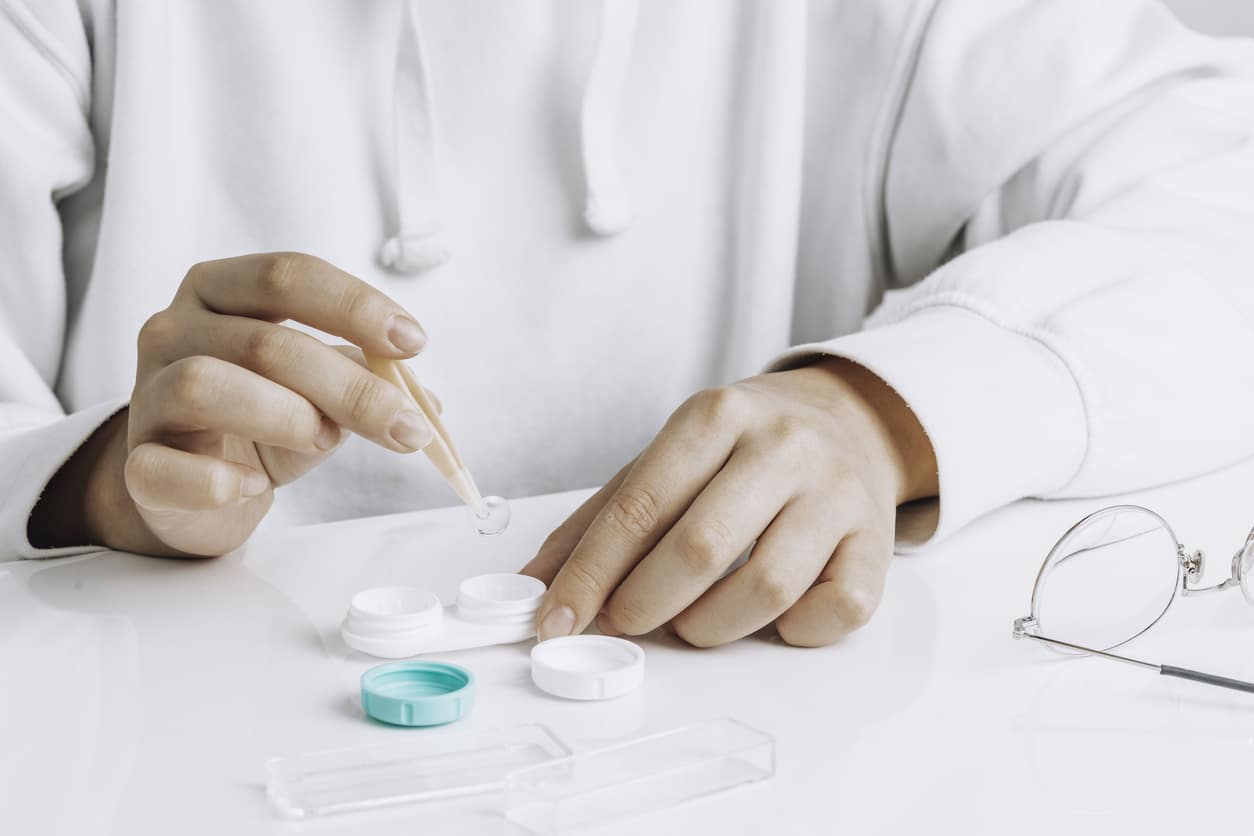Myopia Control in Provo: Treating Nearsightedness
Generally, myopia (nearsightedness) occurs when close-up objects appear clear, but distant objects are blurry. Nearsightedness is a pervasive eye-focusing disorder, and it is estimated that by 2050, nearly half the people in the world will suffer from myopia. Myopia can develop at an early age, and earlier detection of myopia leads to better outcomes for long-term eye health.
With myopia on the rise globally, the introduction of MiSight contact lenses provides a promising solution to slow down the progression of myopia in children aged 8-12. Routine eye exams and early eye exams are essential for detecting myopia in a child’s eyes, as early detection allows for timely intervention. Early intervention and specialized treatments can help manage a child’s myopia and protect a child’s vision, supporting healthy visual development and reducing the risk of future eye health issues. Not only do MiSight® 1-day contact lenses correct nearsightedness, but they are also designed with ActivControl Technology to help reduce the advancement of myopia by an average of 59%, allowing children to maintain clear vision and pursue their interests without glasses.
Personalized care and tailored care are essential for creating an effective treatment plan for each child, ensuring that their unique needs are addressed. Specialized treatments, such as those available in Provo, can help slow the progression of myopia and reduce the risk of high myopia and related eye health issues. Untreated myopia can lead to an increased risk of severe eye disease and other vision complications, making early and ongoing management critical for protecting a child’s long-term eye health.


Myopia Control in Provo: Treating Nearsightedness
Myopia management is a crucial approach for families seeking to safeguard their child’s vision and overall eye health. As nearsightedness becomes more common, especially among children, managing the progression of myopia is more crucial than ever. Myopia causes blurry vision when looking at distant objects, which can interfere with learning, sports, and daily activities. Left unchecked, the progression of myopia can increase the risk of severe vision complications later in life, including retinal detachment and myopic maculopathy.
Fortunately, several effective myopia management strategies are available today. These include specialized contact lenses, such as MiSight 1-day contact lenses, which are designed to slow the progression of myopia and provide clear vision without the need for glasses during the day. Additionally, promoting healthy habits such as spending more time outdoors and taking regular breaks from close-up work can further support your child’s eye health.
In Provo, UT, families have access to advanced eye care and the latest technology in myopia management. Eye care professionals can create a personalized myopia management plan tailored to your child’s unique needs, using a combination of treatments to slow the progression of myopia and reduce the risk of future vision complications. By taking action early, you can help your child enjoy better vision and a healthier future.
What Causes Blurred Vision with Myopia?
For you to see clearly, light rays must first travel through the front layers of the eye (the cornea and lens). The shape and curvature of the cornea’s front surface play a crucial role in how light is focused, and abnormalities in this area can contribute to myopia.
The cornea and lens work together to focus the light so it lands on the back layer of the eye, called the retina. The retina then sends a signal to your brain that allows you to see. For patients with myopia, the cornea may be too steeply curved, or the eye may be longer front to back than usual.
Eye elongation is a key factor in the progression of myopia. In either case, the light rays focus in front of the retina, causing blurry vision at a distance, which makes it challenging to see faraway objects clearly. Some specially designed contact lenses help control myopia by creating blur in the peripheral retina, which can slow down eye elongation and myopia progression.
Habits that can exacerbate this condition include reading in dimly lit areas, spending excessive time on electronic devices, and failing to take breaks from near-work. Increased screen time can cause eye strain, which is a common symptom in children with myopia. Be aware of these habits, and limit your time spent on them to maintain good eye health and reduce the chances of developing nearsightedness.
Outdoor activities and outdoor play are important lifestyle factors that can help reduce the risk of myopia, as the amount of time children spend outdoors is linked to slower progression of myopia. You should also encourage spending more time outdoors, as sunlight exposure can lower the risk of this condition.
Older children may benefit from specific interventions, such as specialized contact lenses to help manage myopia progression and prevent further eye elongation.
Common Symptoms of Myopia in Children
Why is It Important to Catch and Diagnose Myopia?
If left uncorrected, nearsightedness can significantly impact a child’s academic, athletic, or professional performance. Beyond just causing blurred vision, severe myopia can also increase the risk of serious vision problems such as retinal detachment, macular degeneration, premature cataracts, and glaucoma.
Myopia often starts to develop at a young age. It can progressively worsen over time, making it crucial to monitor for signs of this issue to address it and help your child reduce or avoid nearsightedness altogether. By being proactive in addressing the early signs and symptoms of myopia, parents can help their children maintain good vision and overall eye health.

Provo’s Myopia Eye Care FAQs
A new treatment to slow the progression of myopia is now available. Eye Clinic & Aesthetics of Provo has partnered with Cooper Vision, a leading company in the contact lens industry, to provide cutting-edge solutions. They have developed a specialized lens called MiSight, which can dramatically slow the progression of myopia in children.
MiSight is FDA-approved, clinically proven and safe, as well as child-friendly. Its ease of use makes it a viable option for reducing the symptoms and progression of your child’s myopia.
Not at all. MiSight 1-day soft contact lenses offer a promising solution to reducing myopia changes and maintaining a mild/manageable prescription. These lenses, FDA-approved for children aged 8-12, have been clinically proven to slow myopia progression, with a 59% reduction over 3 years and minimal progression over 6 years.
Not only are these lenses safe and effective, but they are also child-friendly and easy to use. With 90% of children being able to insert and remove them independently after three years, they are strongly preferred over glasses.
Conventional treatment options include the use of glasses, contact lenses, or refractive surgery, such as LASIK. At the Eye Clinic & Aesthetics of Provo, we take pride in providing you with the latest technology for spectacle and contact lenses. LASIK can often replace your glasses or contacts, correcting the distance blur caused by myopia.
These treatment options can be discussed and diagnosed during a regular eye exam appointment. If you start noticing issues between appointments, call us today to arrange one and prevent your child’s symptoms of myopia from developing further.
It’s best to start myopia control as early as possible—typically when your child begins showing signs of nearsightedness, which often occurs between the ages of 6 and 12. Early intervention can significantly slow the progression of myopia and reduce the risk of severe eye conditions later in life. During a comprehensive eye exam, our specialists can determine if your child is an ideal candidate for MiSight or other myopia management options.
If left unmanaged, myopia can progress rapidly during childhood, leading to higher prescriptions and increasing the risk of eye diseases such as retinal detachment, glaucoma, and macular degeneration in adulthood. By taking proactive steps early—like using MiSight lenses or other control methods—you can protect your child’s long-term vision health and overall quality of life.
Children undergoing myopia control should have regular follow-up visits every six months, or as recommended by their optometrist. These visits enable our team to monitor any changes in vision, ensure the lenses fit comfortably, and adjust the treatment plan as needed. Consistent follow-up care is key to achieving the best long-term results in slowing myopia progression.
Request an Appointment
Contact the Eye Clinic today to schedule an appointment to see if your child is a good candidate for this myopia control program. Why wait to see how blurry your child’s vision will get when there is a way to stop it in its tracks?
Dr. Smith and Dr. Lewis are passionate about providing our patients with clear vision, while also protecting their future sight. Schedule an appointment today to find out if your child can benefit from myopia management. Call (801) 373-4550 or request an appointment using the link below.
